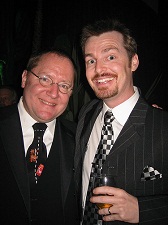 As Cars 2 races into our home theaters, we met again with Pixar’s Victor Navone, who made his debut as Directing Animator on this second instalment of the Cars franchise – a new step in an impressive career.
As Cars 2 races into our home theaters, we met again with Pixar’s Victor Navone, who made his debut as Directing Animator on this second instalment of the Cars franchise – a new step in an impressive career.
Victor got a degree in Fine Arts from the University of California, Irvine and worked for several years in the computer gaming industry as a conceptual designer and 3D artist. In 1998, he began studying 3D character animation in his spare time. One of his early animation exercises, Alien Song, went on to become a popular viral clip on the internet and caught the attention of Pixar Animation Studios, who hired him as a full-time animator in 2000.
His animation credits include the films Monsters, Inc., Finding Nemo, The Incredibles, Cars, Ratatouille and WALL-E, where he earned a character development credit, Toy Story 3 as well as various short projects.
An expert on the world of Cars, we talked with him about his “mater-riffic” work on Cars 2.
Animated Views: Can you tell me about your memories of the first Cars and how you felt being assigned to Cars 2?
Victor Navone: It was 6 years ago that I worked on the first Cars, so my memory of that is a little hazy. It was my first experience working with John Lasseter as a director, and so I felt very lucky; not only because he’s very fun to work for, but also because we all thought that it would be the last feature he would ever direct. I’ve always enjoyed animating simplified characters, so working with Cars came naturally to me, and I quickly developed a knack for them. Because of that I also ended up animating on the short film Mater and the Ghost Light for the Cars DVD, next I directed a Cars-based commercial for State Farm Auto Insurance, and then in 2008 I co-directed four Cars Toons for theatrical and television release.
Needless to say, after all this I was a little burnt out on Cars and I needed to take a brake, so I went back to animation on Toy Story 3. Once Cars 2 started ramping up, I felt like it was a good opportunity for me to take on another leadership roll, so I asked to become a Directing Animator on the film. When I first came on we didn’t know that John Lasseter would end up directing again; that added a nice bookend to my six year Cars journey.
AV: Since Cars, did the upgrading of the technology helped you in animating Cars 2?
VN: For the most part we used the same animation rigs and technology that we had on Cars, only much more refined and stabilized. Our software has, of course, progressed over the years, allowing us faster interaction and playback of our scenes. This was all really helpful, as it allowed the animators with previous Cars experience to ramp up quickly and produce lots of footage. We had a very aggressive schedule on this show, which we were able to meet largely thanks to the simple and consistent rigging of the characters. The greater challenges were for the Effects department, which had to deal with oceans, explosions, smoke, etc.
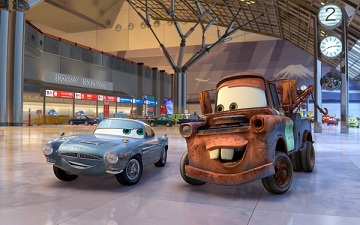
AV: Among all the scenes you animated in Cars 2, what are your favorite ones?
VN: I like animating Mater because he’s one of the broader characters, and luckily I had the opportunity to do a lot of shots with him. Probably my favorite was the shot of him pretending to do karate in the Tokyo airport, because it was very physical and cartoony – not something we get a lot of opportunity to do with car characters. This was one of the first sequences we animated, and I was trying to demonstrate to the other animators how far we could push things. Later on, Andrew Coats animated a scene of Mater fighting in London which was even broader, and it made my shots look tame in comparison!
AV: What were the challenges of the new movie, animation-wise?
VN: The greatest challenge was defining the new characters, such as Finn McMissile and Holley Shiftwell, and coming up with appealing, consistent facial expressions for them. We did a lot of exploration and test animation with these characters, and we built model sheets that the other animators could use for reference. We spent a lot of time educating the animators who were new to the Cars universe to make sure they understood the “rules” of the world and how we approach animating cars. There was also the challenge of scale, since there are so many characters in this film, including background crowds.
AV: Animators are actors with pencils (even in the digital realm). What is your relation to the characters, do you “become” them?
VN: As actors we are always trying to “get into the head” of our characters, and it helps if we can identify with them personally. We also look at a lot of live-action reference, both of the actor who is voicing the roll and of other actors that play a similar character type. Every animator approaches their work differently, and we all have different sensibilities and preferences for what kind of performances we like.

Some animators excel at comedic performances, while others prefer the more serious, subtle scenes. I’m kind of in the middle; I like to have variety. I’ve spent so much time animating Mater that I feel I know him well and I am comfortable animating him in just about any situation. I don’t necessarily identify with him, but I think I have a good grasp of his nature, which is a cross between innocence and swagger. Sort of a puppy-dog meets fat-Elvis.
AV: Do you think the characters from the original opus evolved in the second one?
VN: Most of the characters from the first film remain as they were when we met them. The exception would be Lightning McQueen, who had a large character arc in the first film. Thus in Cars 2 we had to find the right balance of cocky confidence tempered with the compassion he now has for his friends in Radiator Springs. I think the introduction of an even more cocky competitor (Francesco, the Italian formula race car) really helped to bring out some of the playful competitiveness in McQueen that makes him fun to watch.
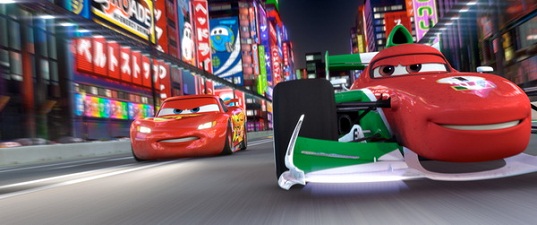
AV: What kind of impact the voice of a character can have on your animation?
VN: The voice acting performances are a huge influence on our animation. They tell us a lot about what the timing and tone of the physical performance should be. Animating to a mediocre reading can be a struggle, as the animator has to work to add entertainment where there is none. Luckily we had some fantastic voice talent on this film, including Michael Caine who brought a real richness to the character of Finn McMissile. When you start with a really entertaining and nuanced voice recording it’s easier to plan your shot; you feel like you’re just adding to something that’s already working. The challenge then becomes to find subtext and add extra details that support or complement the dialog.
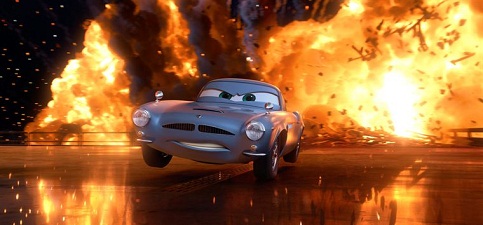
AV: How did you prepare your animation on Cars 2?
VN: I’ll confess I didn’t look at Cars a lot. I’ve seen the film lots of times, and I’ve spent so much time in the Cars universe that I didn’t feel the need to look back. I did prepare a lot of training materials, such as model sheets and demos, for the new animators, which helped me to solidify and articulate my understanding of the “rules” of the Cars world. From there it was really exciting to see what the new animators would do with these characters, and that inspired me to try new things as well. The Supervising Animators, the Director and I also I discussed things we wanted to do differently from the first film. For example, we wanted to tone down the amount we were animating the “brows” on the cars, and we didn’t want to see a lot of movement in Mater’s air-cleaner nose.
AV: Be it Cars, or Wall-E, or Finding Nemo, or Cars Toons, you have worked a lot on physically limited characters. Is it a deliberate choice of yours?
VN: I like animating all kinds of characters, but I do gravitate towards the limited ones. I like the challenge of working with so many limitations and trying to find creative solutions to conveying thought and emotion. I also like that I can produce animation more quickly with a simple character, which gives me more time to experiment. As for expressing feelings, we rely on most of the same techniques for simple characters as for complex characters: timing, posing and caricature. You don’t need complex characters to portray complex emotions. The Muppets have proven that many times over.
AV: You worked ten full weeks on Cars 2. How do you keep your enthusiasm intact every day, every time, when working in such an intensive way?
VN: Actually I worked on the film for about 15 months, though roughly 50% of the film was animated in ten weeks. The schedule was very challenging and I wasn’t always enthusiastic, but working with so many great people helped to keep my spirits high. The Supervising and Directing Animators worked hard to bring a spirit of collaboration to the show, and to give animators a greater sense of ownership. This really boosted morale and made the work more fun. The animators in turn inspired and energized us with their creative work. John Lasseter coming aboard to direct gave the show even more focus and energy, and helped to push us across the finish line. He’s a very inspiring and ingratiating leader.

AV: You had worked along with John Lasseter on Cars Toons. How did you work with him now on his latest feature?
VN: Very well, I think! I’m pretty comfortable working with John at this point, and I think he respects my input and trusts my sensibilities. The big challenge was that John was very busy in other departments for much of the film so we didn’t have as much time with him in animation as we wanted. Often times he would review shots on his iPad during his hour-long commute to work, and his voice-recorded notes would be forwarded to the animators. Other times the Leads would have to approve shots in his stead, and he would see them later. John always trusted us to steward his vision and maintain the quality of the film in his absence.
AV: What kind of a director is John Lasseter?
VN: John is very collaborative, and while he knows what he wants, he’s also open to others’ ideas. He would let us break the animation rules we had established if he felt it worked well for a specific scene. Unfortunately I can’t think of any good anecdotes about this right now…
AV: John Lasseter now runs both Pixar and Disney animation studios. As a Pixar animator, have you ever happened to get in touch with Disney animators?
VN: There is very little interaction between the two studios. We were lucky to have some of the animators from Tangled come up and give a presentation about the techniques they used on that film, but otherwise we tend to stay pretty separate.
AV: What are you be up to, now?
VN: I’ll be starting pre-production on an unannounced film that I’m very excited about!
Our deepest thanks to Victor Navone!
Share this article with others:











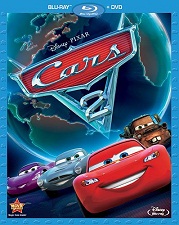
No comments:
Post a Comment
Thank's!